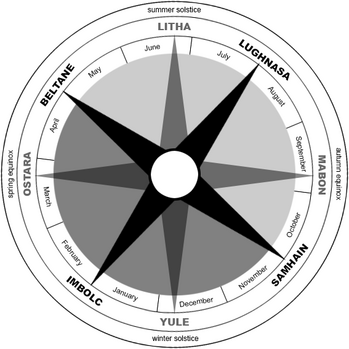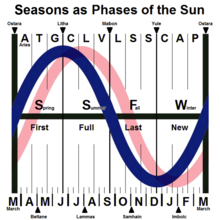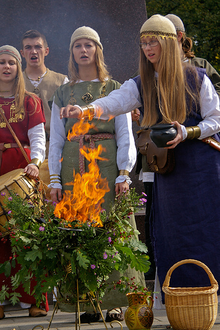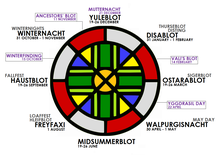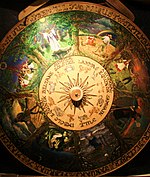
Beltane or Bealtaine is the Gaelic May Day festival, marking the beginning of summer. It is traditionally held on 1 May, or about midway between the spring equinox and summer solstice. Historically, it was widely observed in Ireland, Scotland, and the Isle of Man. In Irish the name for the festival day is Lá Bealtaine while the month of May is Mí na Bealtaine, in Scottish Gaelic Latha Bealltainn, and in Manx Gaelic Laa Boaltinn/Boaldyn. Beltane is one of the four main Celtic seasonal festivals—along with Samhain, Imbolc, and Lughnasadh—and is similar to the Welsh Calan Mai.

The Horned God is one of the two primary deities found in Wicca and some related forms of Neopaganism. The term Horned God itself predates Wicca, and is an early 20th-century syncretic term for a horned or antlered anthropomorphic god partly based on historical horned deities.

Imbolc or Imbolg, also called Saint Brigid's Day, is a Gaelic traditional festival. It marks the beginning of spring, and for Christians, it is the feast day of Saint Brigid, Ireland's patroness saint. Its traditional date is 1 February, about halfway between the winter solstice and the spring equinox. Historically, its traditions were widely observed throughout Ireland, Scotland and the Isle of Man. Imbolc is one of the four Gaelic seasonal festivals, along with: Beltane, Lughnasadh and Samhain.

Lammas, also known as Loaf Mass Day, is a Christian holiday celebrated in some English-speaking countries in the Northern Hemisphere on 1 August. The name originates from the word "loaf" in reference to bread and "Mass" in reference to the Eucharist. It is a festival in the liturgical calendar to mark the blessing of the First Fruits of harvest, with a loaf of bread being brought to the church for this purpose. Lammastide falls at the halfway point between the summer solstice and the autumn equinox. Christians also have church processions to bakeries, where those working therein are blessed by Christian clergy.

Samhain, Sauin or Oíche Shamhna is a Gaelic festival on 1 November marking the end of the harvest season and beginning of winter or "darker half" of the year. It is also the Irish language name for November. Celebrations begin on the evening of 31 October, since the Celtic day began and ended at sunset. This is about halfway between the autumnal equinox and winter solstice. It is one of the four Gaelic seasonal festivals along with Imbolc, Bealtaine, and Lughnasa. Historically it was widely observed throughout Ireland, Scotland, and the Isle of Man. A similar festival is held by the Brittonic Celtic people, called Calan Gaeaf in Wales.

Wicca, also known as "The Craft", is a modern pagan, syncretic, earth-centered religion. Considered a new religious movement by scholars of religion, the path evolved from Western esotericism, developed in England during the first half of the 20th century, and was introduced to the public in 1954 by Gerald Gardner, a retired British civil servant. Wicca draws upon ancient pagan and 20th-century hermetic motifs for theological and ritual purposes. Doreen Valiente joined Gardner in the 1950s, further building Wicca's liturgical tradition of beliefs, principles, and practices, disseminated through published books as well as secret written and oral teachings passed along to initiates.
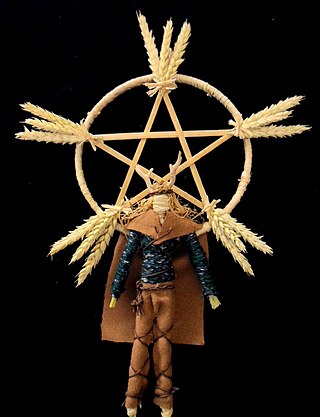
Lughnasadh, Lughnasa or Lúnasa is a Gaelic festival marking the beginning of the harvest season. Historically, it was widely observed throughout Ireland, Scotland and the Isle of Man. Traditionally it is held on 1 August, or about halfway between the summer solstice and autumn equinox. In recent centuries some of the celebrations have shifted to the Sunday nearest this date. Lughnasadh is one of the four Gaelic seasonal festivals, along with Samhain, Imbolc and Beltane. It corresponds to the Welsh Gŵyl Awst and the English Lammas.
The Celtic calendar is a compilation of pre-Christian Celtic systems of timekeeping, including the Gaulish Coligny calendar, used by Celtic countries to define the beginning and length of the day, the week, the month, the seasons, quarter days, and festivals.

Celtic neopaganism refers to any type of modern paganism or contemporary pagan movements based on the ancient Celtic religion. One approach is Celtic Reconstructionism (CR), which emphasizes historical accuracy in reviving Celtic traditions. CR practitioners rely on historical sources and archaeology for their rituals and beliefs, including offerings to spirits and deities. Language study and preservation are essential, and daily life often incorporates ritual elements. While distinct from eclectic pagan and neopagan witchcraft traditions, there is some overlap with Neo-druidism.
M. Macha NightMare is an American Neopagan witch. She was born in Milford, Connecticut and was one of the founders of the Reclaiming Collective in the 1970s.
Green Egg is a Neopagan magazine published by the Church of All Worlds intermittently since 1968. The Encyclopedia of American Religions described it as a significant periodical.
Modern paganism in the United States is represented by widely different movements and organizations. The largest modern pagan religious movement is Wicca, followed by Neodruidism. Both of these religions or spiritual paths were introduced during the 1950s and 1960s from Great Britain. Germanic Neopaganism and Kemetism appeared in the US in the early 1970s. Hellenic Neopaganism appeared in the 1990s.
The Dynion Mwyn tradition is said by its adherents to be derived from Welsh and Pictish religious sources as well as Druidic and witchcraft magical practices.

In the modern Pagan movement of Heathenry there are a number of holidays celebrated by different groups and individuals. The most widely observed are based on ancient Germanic practices described in historical accounts or folk practices; however, some adherents also incorporate innovations from the 20th and 21st centuries.
The Holly King and Oak King are personifications of the winter and summer in various neopagan traditions. The two kings engage in endless "battle" reflecting the seasonal cycles of the year: not only solar light and dark, but also crop renewal and growth. During warm days of Midsummer the Oak King is at the height of his strength; the Holly King regains power at the Autumn equinox, then his strength peaks during Midwinter, at which point the Oak King is reborn, regaining power at the Spring equinox, and perpetuating the succession.
Lists of holidays by various categorizations.
Rhiannon Ryall is the pseudonym of an English-born Australian Wiccan who achieved notoriety for her controversial claims regarding the existence of a group of Wiccans living in England's West Country during the 1940s. These claims were first publicised in 1993 when the English company Capall Bann published Ryall's West Country Wicca: A Journal of the Old Religion, in which she made the claims that when growing up along the borders between the English counties of Devon and Somerset, she was initiated into a local Wiccan tradition that many of the people in the surrounding villages were members of. Claiming that they were "pre-Gardnerian", she asserted that her family had not been Wiccan, and as such she was not a hereditary witch, but that aged sixteen, she, like many other boys and girls who were the same age, were taken to the female "Elders of the village" who taught them about the Craft.

Neopaganism in South Africa is primarily represented by the traditions of Wicca, Neopagan witchcraft, Germanic neopaganism and Neo-Druidism. The movement is related to comparable trends in the United States and Western Europe and is mostly practiced by White South Africans of urban background; it is to be distinguished from folk healing and mythology in local Bantu culture.
The Dun Ailline Druid Brotherhood is a pagan organization for followers of the Celtic Neopaganism based on Spain in 2010, which supports the practice of a type of Celtic Reconstructionist Paganism called Druidism, centered on the Celtic culture of Ireland, and whose principal deities are known as the Tuatha Dé Danann. Its members consider themselves practitioners of a European native religion and they call themselves creidim, a concept of Irish origin.
A magical alphabet, or magickal alphabet, is a set of letters used primarily in ceremonial magic ('magick'), occult practices, and esoteric traditions. These alphabets serve various purposes, including encoding secret messages, conducting rituals, creating amulets or talismans, casting spells, and invoking spiritual entities. Several magical alphabets, including the Celestial Alphabet, Malachim, and Transitus Fluvii, are based on the Hebrew alphabet, which itself has a long history of use in mystical and magical contexts.
